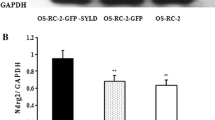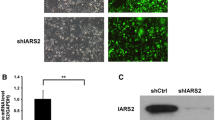Abstract
Objective
To explore the inhibition of ACHN cells via shRNA expression vector mediated cyclinE1 gene silencing.
Methods
The shRNA targeting at cyclinE1 gene was designed and synthesized. By ligation, the fragment was inserted into pGenesil-1-U6 to construct the recombinant plasmid pGenesil-1-U6-cyclinE1. The identified recombinant plasmid was introduced into ACHN cells with lipofectamine 2000. The inhibition of cyclinE1 mRNA and protein expression were analyzed by RT-PCR and western-blotting. MTT method was used for observing cell proliferation and drawing growth curve. The cell cycle and ratios of apoptotic cell were assessed by flow cytometric detection. The ability of invasion and speed of cell migration were detected by transwell chamber invasive models and cell scratch method.
Results
The inhibition of expression of cyclinE1 in ACHN cells mediated by recombinant vector (0.0933 ± 0.05) was significantly lower than that in the group of transfected with empty vector (0.8827 ± 0.04) and the control group (0.9021 ± 0.03) (P < 0.05). Flow cytometry showed that recombinant cells were blocked in the G1 phase and the apoptotic ratio was increased significantly (11.15 ± 4.00)% (P < 0.05). The curves of cell growth indicated that the proliferation of cell transfected with recombinant plasmid was inhibited significantly compared with that in control group (P < 0.05). The results of transwell and cell scratch suggested that the abilities of invasion and migration of the cells transfected with recombinant plasmid were decreased conspicuously (P < 0.05).
Conclusion
The expression of cyclinE1 could be inhibited successfully by RNA interference induced by shRNA expression vector. This consequently inhibits the cell growth and induces apoptosis. Our study provided a preliminary result in searching of RNA interference (RNAi) therapy for renal cell carcinoma.
Similar content being viewed by others
References
Yue H, Jiang HY. Expression of cell cycle regulator p57kip2, cyclin E protein and proliferating cell nuclear antigen in human pancreatic cancer: an immunohistochemical study. World J Gastroenterol 2005; 11:5057–5060.
Zolota V, Sirinian C, Melachrinou M, et al. Expression of the regulatory cell cycle proteins p21, p27, p14, p16, p53, mdm2, and cyclin E in bone marrow biopsies with acute myeloid leukemia. Correlation with patients’ survival. Pathol Res Pract 2007; 203: 199–207.
Bales E, Mills L, Milam N, et al. The low molecular weight cyclin E isoforms augment angiogenesis and metastasis of human melanoma cells in vivo. Cancer Res 2005; 65: 692–697.
Milne AN, Carvalho R, Jansen M, et al. Cyclin E low molecular weight isoforms occur commonly in earlyonset gastric cancer and independently predict survival. J Clin Pathol 2008; 61: 311–316.
Bahnassy AA, Zekri AR, Alam El-Din HM, et al. The role of cyclins and cyclins inhibitors in the multistep process of HPV-associated cervical carcinoma. J Egypt Natl Canc Inst 2006; 18: 292–301.
Hashimoto Y, Naruyama H, Ando R, et al. Molecular targeted therapy for prostate cancer. J Hinyokika Kiyo 2008; 54: 57–61.
Shariat SF, Ashfaq R, Sagalowsky AI, et al. Association of cyclin D1 and E1 expression with disease progression and biomarkers in patients with non-muscleinvasive urothelial cell carcinoma of the bladder. Urol Oncol 2007; 25: 468–475.
Shariat SF, Karakiewicz PI, Ashfaq R, et al. Multiple biomarkers improve prediction of bladder cancer recurrence and mortality in patients undergoing cystectomy. Cancer 2008; 112: 315–325.
Jaronczyk K, Carmichael JB, Hobman TC. Exploring the functions of RNA interference pathway proteins: some functions are more RISCy than others. Biochem J 2005;387: 561–571.
Micklem DR, Lorens JB. RNAi screening for therapeutic targets in human malignancies. Curr Pharm Biotechnol 2007; 8: 337–343.
Paddison PJ. RNA interference in mammalian cell systems. Curr Top Microbiol Immunol 2008; 320: 1–19.
Nauman A, Turowska O, Poplawski P, et al. Elevated cyclin E level in human clear cell renal cell carcinoma: possible causes and consequences. Acta Biochim Pol 2007; 54: 595–602.
Hedberg Y, Ljungberg B, Roos G, et al. Expression of cyclin D1, D3, E, and p27 in human renal cell carcinoma analysed by tissue microarray. Br J Cancer 2003;88: 1417–1423.
Hedberg Y, Davoodi E, Ljungberg B, et al. Cyclin E and p27 protein content in human renal cell carcinoma: clinical outcome and associations with cyclin D. Int J Cancer 2002; 102: 601–607.
Li K, Lin SY, Brunicardi FC, et al. Use of RNA interference to target cyclin E-overexpressing hepatocellular carcinoma. Cancer Res 2003; 63: 3593–3597.
Song HX, Ma WL, Song YB, et al. Growth inhibition of K562 cells by cyclin E gene-specific small interfering RNA. Diyi Junyi Daxue Xuebao 2005; 25: 361–365 (Chinese).
Jiang L, Chen RS, Li JC. Inhibition of cyclinE Expression and Cell Proliferation by small Interfering RNA in Breast Cancer Cell. Xibao Shengwuxue Zazhi 2006; 28:188–192 (Chinese).
Zhu Qc, Gao JP, Lan FH, et al. Studies on inhibition of cyclinE1 expression with siRNA expression vector in hepatoma cells. Zhong Liu 2005; 25: 335–338 (Chinese).
Author information
Authors and Affiliations
Corresponding author
Additional information
This work was supported by a grant from Major State Basic Research Development Program, China (No.2002CB513107).
About this article
Cite this article
Wang, J., Chen, A. & Guo, F. Study on inhibition of growth of ACHN cells via shRNA expression vector-mediated cyclinE1 gene silencing. Chin. J. Clin. Oncol. 6, 29–35 (2009). https://doi.org/10.1007/s11805-009-0029-7
Received:
Accepted:
Published:
Issue Date:
DOI: https://doi.org/10.1007/s11805-009-0029-7




